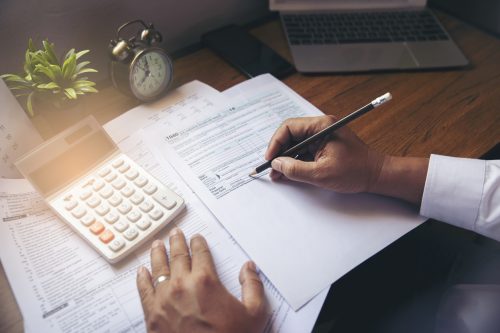The IRS Just Gave This Urgent Last-Minute Warning to Taxpayers

April 18 is right around the corner, meaning you have just a week and a half to file your 2021 tax return. The filing process can be daunting, and for those of us who have yet to get started, Tax Day seems to loom that much closer. However, even if you’ve already filed, there may be another step you need to take by that April 18 deadline. Read on to learn more about an urgent warning the Internal Revenue Service (IRS) just issued for a certain group of taxpayers.
RELATED: The IRS Just Cautioned Taxpayers Against Doing This.
If you need to make estimated federal tax payments, the first deadline is April 18.

According to the IRS, income taxes are a “pay as you go” system, meaning as you earn income over the course of the year, you also pay taxes. Oftentimes, your taxes are withheld by your employer or via pension plans, Social Security benefits, or other government payments (including unemployment).
If your income is not subject to withholding, you are required by law to estimate your tax payments quarterly. This generally applies to people who are self-employed, retirees, investors, businesses, and corporations—all of whom will need to make their first quarterly payment for 2022 by April 18.
If you don’t make these estimated payments or pay enough tax through withholding during the year, this could lead to a penalty. Making these payments late can also be problematic and incur a fine—even if you are set to receive a refund when you file your tax return.
How do I know if I’m required to make estimated tax payments?

According to the IRS, more and more taxpayers have been penalized as a result of underpaying taxes. Between 2010 and 2015, the number of people who paid estimated tax penalties increased by 40 percent, jumping from 7.2 million to 10 million taxpayers. Penalties can be several hundreds of dollars, which is all the more reason to check and see if you need to be estimating taxes.
According to the IRS, this requirement affects those who are self-employed and those in the gig economy—meaning you are an independent contractor, an online platform worker, or in a temporary position. Even if you are not an employee of the company or issued an income statement (think a W-2 or 1099), the income you make is still taxable.
As retirees and investors have large portions of income that are not subject to withholding, they are also required to make estimated tax payments. If you earn interest income, dividends, prices, or rental income, this requirement could also apply to you. Another hint you fall into this category is when you anticipate owing at least $1,000 in taxes. However, certain higher-income taxpayers, as well as farmers and fishermen, have different estimated tax requirements, the agency said.
RELATED: For more financial advice delivered straight to your inbox, sign up for our daily newsletter.
Here’s how to figure out your estimated taxes.

Form 1040-ES is used to help you calculate your estimated tax payments. You will need to determine your expected adjusted gross income (AGI), taxable income, taxes, deductions, and credits for the year. The IRS advises referring to your income, deductions, and credits from last year, and using your 2020 tax return as a guiding tool. While this process sounds like it might be overwhelming, a worksheet on the 1040-ES form can also help you figure out how much you owe. The IRS further reassures taxpayers that you can complete an additional 1040-ES form for the next quarter, in the event you overestimate or underestimate your earnings. That being said, they recommend being as accurate as possible in order to avoid penalties.
If you need to make an estimated payment, the best way to do so is online.

The easiest way to make estimated payments is through IRS Online Account, the agency said, as taxpayers can view payment history, any pending payments, as well as additional tax information. You can opt to pay all of your estimated taxes by April 18, or you can pay by each quarterly due date—April 18, 2022, June 15, 2022, Sept. 15, 2022, and Jan. 17, 2023.
Other easy ways to pay include IRS Direct Pay, which takes money directly from your bank account, as well as using a debit or credit card, an electronic fund withdrawal, or the Treasury Department’s Electronic Federal Tax Payment System (ETFTPS). If you need more time to pay, you can apply for a payment plan to help avoid penalties.
RELATED: The IRS Now Won’t Let You Do This Until After April 18.